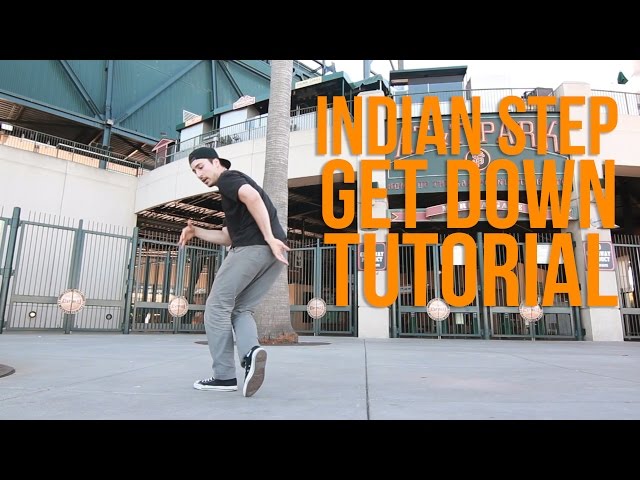Breaking, or breakdancing as it’s popularly known, is a dance form that combines creativity, athleticism, and rhythm in a spectacular display of movement. A critical aspect of breakdancing is the ability to transition smoothly between moves, ensuring a flow that matches the intensity and rhythm of the music. Today, we delve into a detailed breakdown of a fundamental move in breakdancing: the Indian Step Get Down. This move is a variation that transitions from top rock to footwork, adding flair and complexity to your routine.
Introduction to Indian Step Get Down
The Indian Step is a classic breakdancing move that serves as the backbone for many variations and get downs in b-boying. It’s about connecting the vibrant energy of your top rock with the intricate, ground-level footwork that defines breaking. To master the Indian Step Get Down, it’s essential to focus on the seamless transition between standing moves and floor-based actions.
The Basic Moves
Step 1: Understanding the Standard Indian Step
Before we dive into the get down, it’s crucial to grasp the basic Indian “P” or “PO” step. The move begins with a kick across your body, maintaining a rhythmic swing that syncs with the beats. The traditional Indian Step involves a series of kicks and steps that alternate rhythmically, setting the stage for more complex variations.
Step 2: The Variation and Transition
Milestone from Renegade Rockers introduces a unique twist to the Indian Step, which involves an enhanced series of movements:
- Kick to the Side: Start your move by kicking out to the side.
- Out, Back, Over: After the side kick, swiftly move your front foot out, jump back, and then transition over to the other side.
- Repeat: Continue this sequence, emphasizing the rhythmic flow. The key here is the rapid switching of the feet, which might feel counterintuitive initially as it differs from the traditional Indian Step where the feet switch more naturally.
This sequence focuses heavily on the rhythm and requires that you maintain the same beat consistency as in the simpler Indian Step.
Breaking Down the Transition
Transitioning to the ground, also known as the “get down”, is where you take the step from above and bring it into your footwork. Here’s how Milestone breaks it down:
- Perform the Variation: Start with the kick and over, followed by out, back, and over.
- Ground Transition: At the end of a set (for example, after two repetitions), use the last ‘over’ to place your hand on the ground and transition the step into a ground-based footwork pattern.
- Mimic the Move on the Ground: Once on the ground, repeat the same kick and over movement, but this time incorporate your hands and upper body to stabilize and add style.
Tips for Smooth Execution
- Speed and Fluidity: Practice the move slowly at first to get a feel for the transitions and the required body movements. Gradually increase your speed as you become more comfortable.
- Body Hinging: A critical aspect is the hinging movement of your body. As you kick out, hinge forward slightly to help propel your body into the next movement efficiently.
- Hand Placement: When transitioning to the ground, placing your hand correctly is vital for balance and to continue the flow without interruption.
Adding Flair and Personal Style
After mastering the basic get down, adding personal flair and modifications can really make the move your own. Milestone suggests incorporating elements like the “Peter Pan” step, where one foot hooks across before snapping back, adding a dynamic twist to the routine.
Practice and Patience
Like any breakdancing move, the Indian Step Get Down requires practice. It’s a move that not only tests your rhythm and coordination but also your ability to infuse personality into your dance. Practicing with different music and tempos can help you adapt the move to various styles.
Conclusion
The Indian Step Get Down is more than just a dance move; it’s a statement of style, rhythm, and individual expression in the world of breakdancing. By taking the time to learn and perfect this move, you’re not just learning to dance; you’re learning to tell a story with your body. Remember, breakdancing is an evolving art form—never stop exploring, adapting, and adding to your repertoire. Stay funky, and keep breaking!
For those looking to dive deeper, check out Milestone’s tutorials on YouTube or visit his website for more intricate breakdancing lessons. Remember, the key to mastering breaking is consistent practice and always pushing the limits of your creativity and physicality. Keep the beat, and peace out!
Author Profile
Latest entries
 Break DanceAugust 26, 2024ULTIMATE AIRFLARE TUTORIAL (2024) – COACH SAMBO
Break DanceAugust 26, 2024ULTIMATE AIRFLARE TUTORIAL (2024) – COACH SAMBO Break DanceAugust 26, 2024BEST WINDMILL TUTORIAL – COACH SAMBO – HOW TO BREAKDANCE
Break DanceAugust 26, 2024BEST WINDMILL TUTORIAL – COACH SAMBO – HOW TO BREAKDANCE Break DanceAugust 26, 2024BEST AIRFLARE TUTORIAL – BY SAMBO – HOW TO BREAKDANCE (#6)
Break DanceAugust 26, 2024BEST AIRFLARE TUTORIAL – BY SAMBO – HOW TO BREAKDANCE (#6) Break DanceAugust 26, 20245 BEGINNER FREEZES – HOW TO BREAKDANCE – BY COACH SAMBO
Break DanceAugust 26, 20245 BEGINNER FREEZES – HOW TO BREAKDANCE – BY COACH SAMBO






Leave a reply